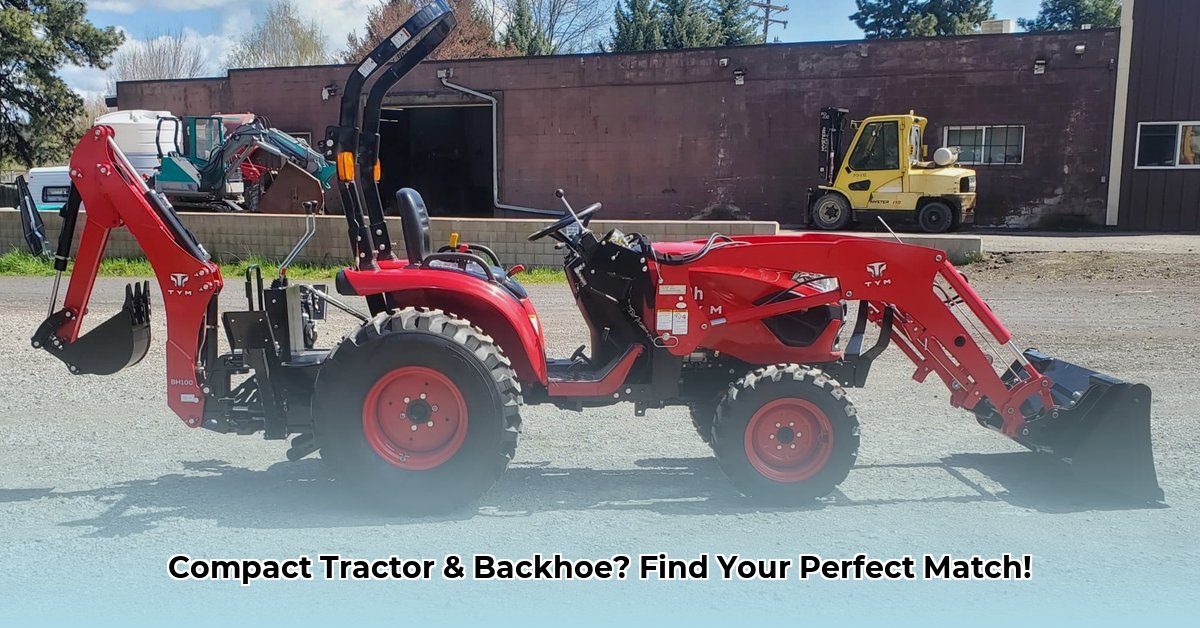
Buying a compact tractor and backhoe is a significant investment for smallholder farmers and acreage owners. This guide provides actionable steps to select the best machine for your needs, budget, and sustainability goals, combining technical information with practical advice and model comparisons. For more information on pricing, check out this helpful resource on tractor costs.
Key Factors to Consider When Choosing Your Tractor and Backhoe
Choosing the right compact tractor and backhoe involves careful consideration of several key factors. Think of it as choosing a vehicle—you wouldn't use a sports car for hauling lumber. Similarly, the correct tractor depends on your specific needs and budget.
1. Assessing Your Land and Operational Needs: The size of your property significantly impacts the horsepower you need. A few acres require less power than 50 acres. Consider the tasks: Will you primarily dig post holes, or do you need to move large amounts of topsoil or clear brush? A larger, more powerful tractor might save you time and effort in the long run, but it will also cost more. Will the terrain be flat or hilly? Four-wheel drive is essential for challenging terrain.
2. Setting a Realistic Budget: Budgeting goes beyond the purchase price. Consider:
- Initial Cost: Compact tractor and backhoe prices vary widely.
- Maintenance: Regular servicing is crucial for longevity and cost-effectiveness.
- Fuel Expenses: Fuel efficiency directly impacts your operational costs. A more fuel-efficient machine saves money over time.
- Potential Repairs: Budget for unexpected repairs or consider an extended warranty.
3. Essential Features to Prioritize: Certain features are critical for functionality and safety.
- Four-Wheel Drive (4WD): 4WD dramatically increases traction, especially on uneven terrain or in wet conditions, improving safety and efficiency.
- Hydrostatic Transmission: Offers smooth speed and direction changes, essential for maneuverability in tight spaces and for precise control during delicate operations.
- Roll-Over Protective Structure (ROPS): A critical safety feature protecting the operator in case of a rollover. Never compromise on safety.
- Power Take-Off (PTO): This allows you to power various attachments, expanding the tractor's versatility for tasks such as tilling, mowing, and snow-blowing (depending on attachments).
- Backhoe Attachment: Make sure the backhoe's digging depth, bucket size, and power suit your needs.
4. Sustainability and Long-Term Costs: Consider environmental and economic factors.
- Fuel Efficiency: Fuel-efficient models minimize running costs and reduce your environmental impact. Look for models with high horsepower-to-fuel consumption ratios.
- Longevity and Repairability: A well-built machine with readily available parts translates to a longer lifespan and lower long-term costs. Choose a model known for its durability and ease of repair.
Model Comparisons: A Closer Look at Popular Brands
Several reputable manufacturers offer compact tractors and backhoes. This isn't an exhaustive list, but we'll compare some popular choices to highlight key differences. Always conduct thorough research before purchasing.
| Feature | John Deere 1025R | Kubota BX23S | Considerations |
|---|---|---|---|
| Price Range (USD) | ~$25,000 - ~$35,000 | ~$20,000 - ~$30,000 | Consider your budget and required features. |
| Horsepower | 25HP | 23HP | Match horsepower to your land and workload. |
| Fuel Efficiency | Good | Good | Crucial for long-term cost savings. |
| Warranty | Check Manufacturer Specs | Check Manufacturer Specs | A longer warranty reflects manufacturer confidence. |
| Key Features | Hydrostatic, 4WD, ROPS, PTO | Hydrostatic, 4WD, ROPS, PTO | Prioritize features based on your specific tasks. |
John Deere 1025R: Known for its user-friendly design and robust performance. It’s a strong option for various tasks on smaller properties.
Kubota BX23S: Kubota often provides a wider array of models, enabling a more customized selection. These tractors are typically compact, maneuverable, and reliable.
Addressing Potential Risks and Mitigating Them
Buying a compact tractor and backhoe presents some risks:
- High Initial Cost: Explore financing options (loans or leases) to manage expenses.
- Mechanical Issues: Purchase from reputable dealers with good service and support. Regular maintenance is crucial, and an extended warranty adds peace of mind.
- Fuel Costs: Efficient operation and proper maintenance minimize fuel consumption.
- Attachment Compatibility: Verify attachment compatibility before purchase.
- Environmental Impact: Choose fuel-efficient models to minimize your environmental footprint.
Regulatory Compliance: Meeting Legal Requirements
Before purchasing, check local and national regulations regarding emissions, safety, and noise levels. Ensure your chosen tractor and backhoe comply with all applicable guidelines.
Conclusion: Making an Informed Decision
Choosing the right compact tractor and backhoe requires careful planning. By considering your budget, land size, operational needs, and essential features, you can find the perfect fit. Thorough research, consultation with professionals, and consideration of long-term costs (including fuel efficiency and maintenance) are crucial for a successful purchase.